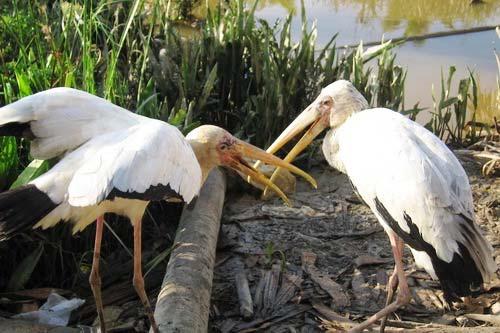Social media video featuring the project.
Rediscovery a breeding colony Milky stork in Sumatra
15 Apr 2008 Sumatra, Indonesia, Asia Birds | Habitats
Survey and Conservation of Bird Diversity in Bangka Island, Sumatra, Indonesia
This project will produce basic data to give information on recent population, status, distribution, movements, condition of remaining habitats, breeding sites, threats and other aspects of Milky stork conservation in Sumatra.

Milky storks. © Muhammad Iqbal
The Milky stork has a small, declining population owing to loss of coastal habitat, hunting and trade. These factors are predicted to cause rapid declines in the near future. It therefore qualifies as Vulnerable (Birdlife International 2001 and Birdlife International 2004). Given that most of the population occurs in Sumatra, it is trend there that largely determine the species status. In particular, could the population have declined by >50% over the last three generations (24 years, extrapolating from Ciconia spp.), as this would qualify the species for Endangered status (http://www.birdlifeforums.org/WebX?13@@.2cba53f8/1). The global stronghold of the species is Sumatra, where its primarily distributed along the coasts in east coastal swamp of Aceh, North Sumatra, Riau, Jambi, South Sumatra and Lampung, with breeding recorded in the latter two of these (van Marle and Voous 1988).
This project “Survey and conservation of Milky stork Mycteria cinerea in the east coastal of Sumatra Island, Indonesia” will collect field data record, provide and disseminate data and information. Field surveys will be carried out in six provinces where the most population of Milky stork distribute. The project areas cover at least 25 Wetland Sites (based on Wibowo & Suyatno 1998), 10 Important Bird Areas (based on Holmes & Rombang 2001), 4 National Parks, 4 protected areas and 1 Ramsar Site.
The survey will be undertaken within 2008-2009 with several months for field trips, data analyses, report preparation and report dissemination. This project will serve a basic data to give information on recent population, status, distribution, movements, condition of remaining habitats, breeding sites, threats and other aspects of Milky stork conservation in Sumatra. Conservation awareness among local people will be conducted during surveys with distribute of 1500 poster-calendars of Milky stork. If possible, the village head will meet whenever possible, and the survey aims discussed. Recruitment, on the job training and coordination of team members from six provinces will help to making a substantial and long-lasting contribution to Milky stork and waterbird conservation network and spread understanding about the important of this threatened stork.
This project will also provide excellent opportunities to develop young scientists and conservationists develop their career in conservation. Activity of the project will be an important link to consolidate the existing cooperation and expertise among local scientist and conservationists in conservation globally threatened waterbird and mangrove forest.
Social media video featuring the project.
Rediscovery a breeding colony Milky stork in Sumatra